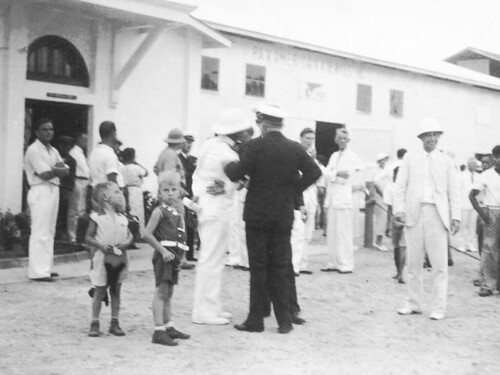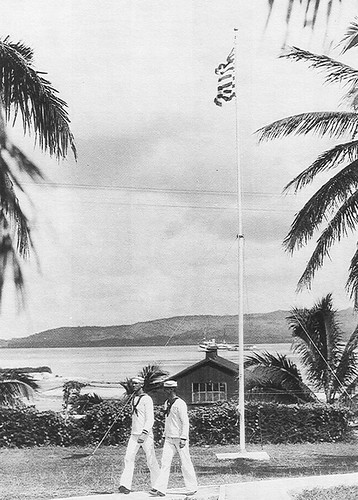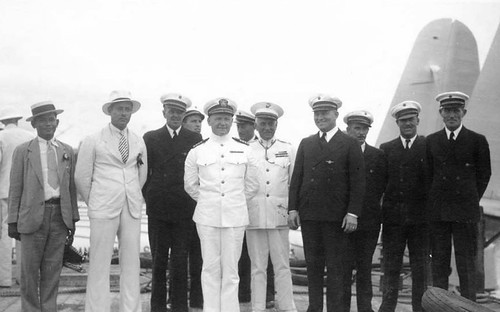All Micronesian islands under Japan’s rule except Guam
In the US Naval Era of Guam (1898-1941), life was generally as it had been for decades. Except for the presence of a small Navy contingent, the PanAm Clipper Service and the Cable Station at Sumai, Guam was basically a land of farmers and fishermen, with people living a simple lifestyle.
When war came 8 December 1941 it was devastating.
The first war to visit the island and its people came during the Spanish colonization. Though Ferdinand Magellan had come upon the island in 1521 and the explorer Legaspi had “claimed” Guam for the Spanish crown in 1565, it wasn’t until 1668 that the Spanish began to colonize the Marianas.
In that year, the Mariana Islands became the focus of Spanish Catholic missionaries, notably the Padre Luis de San Vitores, and his accompanying military protectors. The Spanish also wanted the island as a rest and watering stop for the Galleon Trade between Acapulco and Manila.
The effort to bring Catholicism to the island was successful – today, the great majority of the people are Catholics – but the price to Guam and its native people was costly. The resistance of the indigenous people to the Spanish resulted in 20 years of conflict and war with the Spanish military. That and the introduction of Western disease reduced the population from estimates as high as 100,000 down to a low of 4,000.
By the time the United States took Guam in 1898 in the aftermath of the Spanish-American War, the native Chamorro population was only about 10,000. The rest of the Mariana Islands were sold to Spain and were later acquired by Japan as the US only wanted Guam.
By 1898, the people and the island were at peace though they had been neglected by Spain for many years as its empire was fading into history. In spite of America’s rise in power and influence around the world, the life of the people of Guam saw relatively little change in the transition from being one nation’s colony to being a possession of another. A great part of the reason for that was the ambivalence, and ignorance, of the United States toward the Pacific and Oceania.
Because Guam was merely looked upon by the Navy as a coaling station for its ships as they sailed the Pacific, the island changed little, although the military did add to the economy by buying from farmers and fishermen and employing people.
Naval administrators of the island ran government departments such as schools, a hospital, courts and police, but overall the island’s lifestyle changed little. Chamorros had not gained in terms of a democratic government; a House of Assembly served as a legislative body but it was merely advisory. Chamorro self-determination was non-existent. The naval governor still possessed absolute authority – he was legislator, chief executive and judge.
Japanese had business community on Guam
Japan, though, was much more active in the region. When the opportunity arose in World War I as Germany was reeling from its defeat in Europe, the Japanese were unfurling the flag of the Rising Sun in Micronesia, formerly German-held islands, above the equator. Their presence in the central and western Pacific was vast, as vast as the area of the continental United States: from the Marshall Islands in the east, to the Carolines, to the Marianas and anchoring the line of Japanese-occupied islands was the Palau archipelago. In the Treaty of Versailles which ended World War I, Japan’s occupation of these islands was formalized under a mandate of the League of Nations. Only Guam was under US control.
The Japanese, which had a strong economic presence in the islands even before World War I, was now sowing its influence upon the islands through schools, agricultural programs, and, what would later prove deadly to American Marines and soldiers, the fortification and buildup of the islands as military installations.
With little political or financial support coming from Congress to fortify Guam, the United States signed an agreement with Japan in 1921 at the Washington Naval Conference. The two nations along with other world powers agreed not to fortify their possessions in the Pacific.
Japan’s designs on the islands began taking on a militaristic tone, however, and by 1935 the country refused inspection of the islands under the mandate and walked out of the League of Nations. The action was typical of Japan in those times as the nation, causing worry and concern for all those in Asia and in the Pacific, was growing more and more committed to a policy of aggression.
Only then did the United States begin thinking of fortifying Guam, and in 1938 a Navy study did recommend that the island’s naval facilities be improved to the point where they could support a fully-equipped and operational fleet to help in the defense of the Philippines. But the price tag – possibly tens of millions of dollars – needed for such a buildup was considered too high.
It was in this atmosphere that in December 1941 the people of the United States and Guam began paying – in blood – for a war that suddenly swept the nation and the island into years of struggle, years of sadness, years of tragedy.
By Paul J. Borja
Editor’s note: A version of this historical account was originally written for the 50th Anniversary Booklet of Guam’s Liberation in 1994.
For further reading
Palomo, Tony. An Island in Agony. Self-published, 1984.
Price, Willard. Japan’s Islands of Mystery. New York: John Day Company, 1944.
Rogers, Robert. Destiny’s Landfall: A History of Guam. Honolulu: University of Hawai’i Press, 1995.






